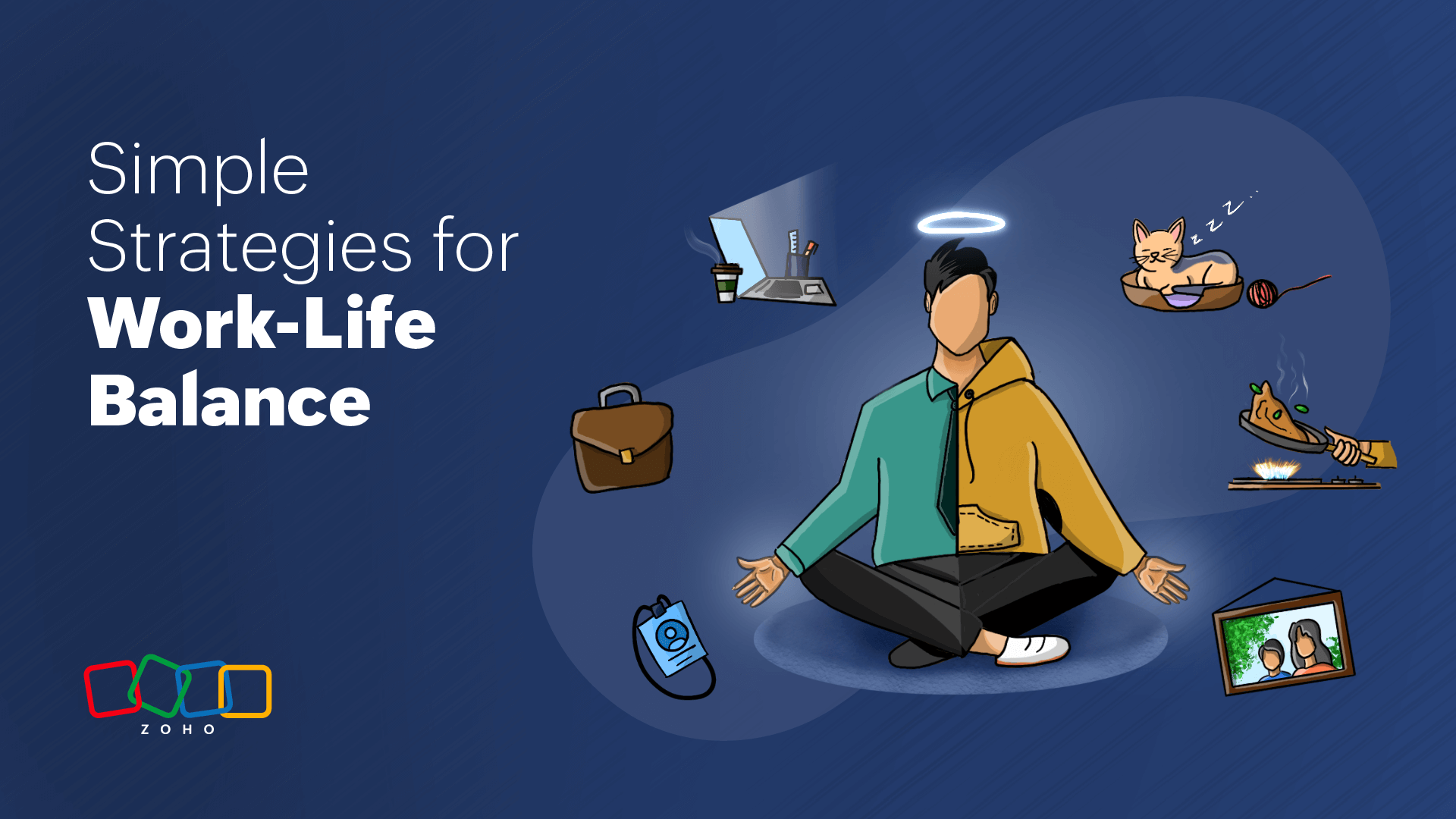- HOME
- All Products
- Work-life balance: Finding harmony in your life
Work-life balance: Finding harmony in your life
- Published : June 27, 2023
- Last Updated : August 22, 2024
- 2.2K Views
- 7 Min Read
Work and life are two important aspects of our lives that are constantly intertwined. Finding a perfect balance between the two has become a persistent challenge for many people. However, rather than focusing on balance, it's essential to acknowledge that work and life aren't two separate entities that can be balanced against each other, but rather a circle that feed into one another. As Jeff Bezos once explained, if you're happy at home, you have tremendous energy for work, and if you're happy at work, you go home with tremendous energy. Therefore, it's essential to understand that both work and life are equally important, and one should strive to find a way to balance both aspects.
Work-life balance involves creating a healthy balance between the amount of time and effort spent on work-related tasks and the amount of time and energy devoted to personal interests, family, friends, and other non-work-related activities.
Why do you need balance between work and your personal life?
Achieving a positive work-life balance can have many benefits, including:
Reducing your stress levels:
When you have balance between your work and your personal life, you're better able to manage stress and maintain your overall well-being.
Improving your physical and mental health:
A positive work-life balance can help prevent burnout, mental exhaustion, and other health problems related to chronic stress.
Creating better job satisfaction:
When you have a better balance between work and personal life, you're more likely to be satisfied with your job and feel more fulfilled in your career.
Increasing your productivity:
By taking breaks and engaging in activities outside of work, you can recharge your batteries and come back to work feeling refreshed and more productive.
Building stronger relationships:
A better work-life balance can help you build stronger relationships with your family, friends, and loved ones, because you have more time to devote to these important relationships.
Improving your time management:
When you have a balance between your work and your personal life, you're better able to manage your time and prioritize your tasks effectively.
To grasp the importance of work-life balance, it may be helpful to explore a case study. By doing so, we can gain a better understanding of how achieving this balance can positively impact our lives.
Jerry and Jose are two employees working at the same company. Here's a comparison of their half-year employee review report.
EMPLOYEE INFORMATION | ||
Employee name | Jerry | Jose |
Review period | 6 months | 6 months |
|
|
|
Ratings by skill area | 0–Poor 1–Fair 2–Good 3–Excellent | |
|
| |
Work quality | 1 | 3 |
Comments | Work quality improved since last review | Work product is complete, and accurate |
Productivity | 1 | 2 |
Comments | Needs to focus more to achieve better results | Has been consistent, focused, and productive and is at the right pace |
Communication | 2 | 3 |
Comments | Conveys effectively, but needs to listen more actively to understand ideas better | Listens well and conveys details in a timely, clear and concise manner |
Collaboration | 2 | 3 |
Comments | Flexible and willing to cooperate, demonstrated innovation | Flexible and patient, seeks group participation to improve work and sets priorities, innovative |
Initiative | 1 | 3 |
Comments | Needs to work on improving initiative | Generates ideas and initiates actions to solve problems actively, creative |
Punctuality | 1 | 2 |
Comments | Good punctuality and meets deadlines | Meets deadlines consistently, maintains proper work schedule |
OVERALL RATING | 1.33 | 2.66 |
To understand this employee report better, let's compare some aspects of their daily routine and how those aspects affected their work-life balance.
Sleeping habits:
Jerry sleeps late and as a result, he struggles to wake up in the morning. This leads to him feeling tired and drowsy throughout the day, affecting his productivity and work-life balance. Jose maintains a healthy sleep routine and wakes up early, feeling refreshed and energetic.
Commuting:
Jerry's long commute to work adds to his stress and fatigue, making it difficult for him to focus on his work. Jose manages to reach the office on time because he sets aside sufficient time for his commute.
Productivity:
Jerry's lack of focus and productivity at work leads to him skipping breaks and feeling stressed about not meeting deadlines. Jose is fully focused and productive at work, which allows him to balance work and breaks effectively.
Family time:
Jerry's work-life imbalance spills over into his personal life, leading to arguments and fights with family members. Jose gets home and spends quality time with his family, engaging in hobbies and other activities.
Mental health:
Jerry's lack of sleep and constant stress at work leads to him feeling low and useless, and this spills over into his personal life. This can negatively impact his mental health in the long run. Jose's healthy sleep routine, exercise habits, and balance between work and personal life can positively impact his mental health.
Food habits:
Jerry's poor sleep routine and lack of time in the morning lead him to skip breakfast, which can affect his productivity and energy levels. Jose follows a healthy breakfast routine and has time to exercise, leading to better overall health and well-being.
Overall, it's clear that Jerry's lack of attention to his daily routine is affecting his performance at work and work-life balance, leading to burnout and stress, whereas Jose's disciplined morning routine helps him achieve a better balance between work and his personal life, leaving him fulfilled and happy.
5 tips for achieving a healthier work-life balance
Achieving a positive work-life balance is crucial for your overall well-being, but it can be challenging. Here are some tips that can help:
1. Set boundaries
It's essential to set clear boundaries between work and personal life by defining specific work hours and not checking work emails or taking work calls during personal time.
2. Prioritize
Allocate time to activities that matter most, such as spending time with family, pursuing hobbies, or volunteering. Prioritizing tasks helps you stay organized and reduces stress and anxiety.
3. Learn to say no
It's okay to say no to activities or tasks that don't align with personal priorities, including work requests that interfere with personal time.
4. Take breaks
Taking regular breaks throughout the day can help individuals recharge and be more productive. This includes taking a lunch break, going for a walk, or practicing mindfulness.
5. Use technology wisely
Business technology can be a double-edged sword when it comes to achieving a positive work-life balance. It can make work more flexible, but it can also make it harder to disconnect. Therefore, it's essential to use technology wisely and set boundaries around its use.
Steps for effectively managing your workload
Here are some more steps you can follow to help you manage your workload effectively and prioritize tasks.
1. Take note of how much time you have in a day to work.
Allocating time in your day to complete your tasks helps you plan your work accordingly.
2. Make a list of all of the work items that you need to complete.
Having a clear to-do list helps you prioritize your work and stay organized.
3. Prioritize the list in descending order of importance.
Focusing on critical tasks first can help you stay on top of your workload and make the most of your time.
4. Discuss each work item with your team or colleagues.
Clear communication can help ensure that everyone is seeing eye-to-eye, which will improve the quality of the work.
5. Split work into segments and take short breaks.
Focusing on work for 25 minutes and taking a break for a minute or two can help you improve your productivity and avoid burnout.
Tech tools and tips for achieving a positive work-life balance
Incorporating technology into your routine can be a game-changer to achieving a better work-life balance. Here are some tech tools and tips that can help.
Embrace remote work options
Consider utilizing workplace and mail suites to facilitate real-time collaboration with your colleagues, regardless of your location.
Stay organized with task management tools
Utilize calendar applications, task managers, to-do lists and note-taking apps to prioritize tasks and reduce stress. These tools can also help you avoid procrastination and stay on track.
Leverage communication tools to stay connected
Use instant messaging, video conferencing, and email to stay in touch with colleagues, customers, and clients, without the need for physical presence. This can save you time and reduce the need for commuting.
Monitor your physical health
Incorporate wearable devices like fitness trackers and health monitors to monitor your physical activity, sleep patterns, and stress levels. These tools can provide valuable insights and help you make more informed decisions about your health.
Prioritize mental health with wellness applications
Take care of your mental health and overall well-being by using wellness applications that offer guided meditations, mindfulness exercises, and other tools to manage stress and promote relaxation.
Incorporating technology into our daily routines can be a powerful tool in achieving work-life balance. By leveraging tech tools like remote work options, task management, communication tools, wearables, and wellness apps, we can streamline our workflows, monitor our physical and mental health, and stay connected with our colleagues and clients. By combining these tools with the tips from this blog post, we can create a personalized approach to work-life balance that works for us, leading to a happier, healthier, and more fulfilling life.
Wrapping up
In conclusion, work-life balance is essential for our overall well-being, and it's possible to achieve it by following practical tips and leveraging technology. By setting boundaries, prioritizing tasks, taking breaks, practicing self-care, and utilizing tech tools, we can create a healthier balance between our work and our personal life. Although it may take some effort and trial and error to find what works best for us, the results are worth it. With a balanced approach to life, we can improve our mental and physical health, enhance our relationships, and, ultimately, live more fulfilling lives.
 Janani
JananiJanani is a product marketer for Zoho Workplace. She enjoys expressing her thoughts creatively while maintaining simplicity for better understanding. Janani has a passion for dance and connecting with nature. And of course, she loves her food!



